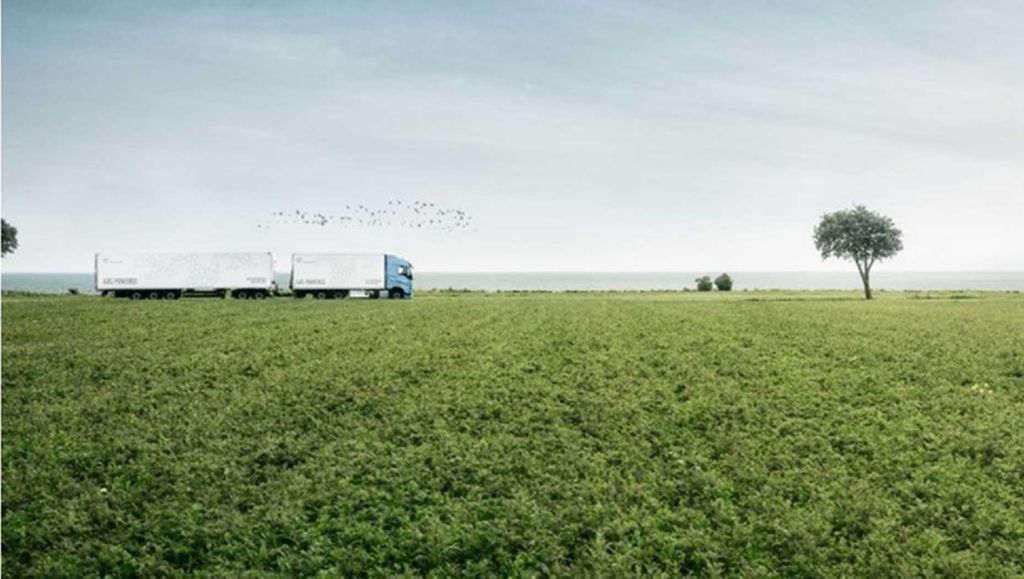Will your next truck be fuelled by Bio-LNG?


It’s easy to see why Bio-LNG (otherwise known as liquefied biogas) is promising. Firstly it’s a true ally of the circular economy as it can be made from feedstock like non-edible parts of grain, sewage and household waste. This means that Bio-LNG doesn’t compete with the food supply—something for which biofuels have been widely criticized for.
The process to make biogas is pretty straightforward. In a biogas facility, various sources of feedstock is placed in a warm, oxygen-free environment and digested by bacteria. In the fermentation process complex molecules of organic matter are broken down into simpler molecules such as alcohol, CO2 or methane renewable gas which can be used to for heat and power.
When biogas is purified or upgraded to natural gas quality (then mostly referred to as biomethane) it can be compressed to Bio-CNG (compressed biogas) or liquefied to Bio-LNG (liquefied biogas) and used in vehicles. Bio-LNG is a highly efficient fuel with minimal CO2 emissions that can also be produced locally which cuts costs and transport emissions.
But despite its green credentials Bio-LNG has had a tough time gaining a major foothold in the trucking industry mainly due to:
Cost: Even though biogas is made from “waste” and is relatively easy to produce, the cost for producing it is still higher than the cost of diesel. In big part that’s because of issues such as economies of scale and distribution costs. The production of biogas has traditionally been handled by municipalities at a local level. It has lacked the scale and incentives to be truly efficient since the primary purpose most of the time has been waste treatment.
Added to this is the fact that building biogas plants is a complicated venture with many prerequisites including access to organic waste, ensuring the right temperatures, moisture, and type of waste to support methane-emitting bacteria. It also has to produce enough gas to make the cost of the facility worthwhile. Refilling infrastructure for Bio-LNG, which is sporadic in most countries, is hard to develop due to cost insufficient incentives and growing market.
Rise of other alternatives: With the growing hype over electric vehicles, some attention, and to some extent investments, have been diverted away from alternatives like Bio-LNG. Some OEMs for instance have ruled out further investments into LNG (liquefied natural gas) and instead focusing on hydrogen or electric vehicles.
So does all this sound the death knell for Bio-LNG?
Hardly. And here is why.
Thanks to the rise of the circular economy there has been a shift in attitudes – what farmers, supermarkets and municipalities previously saw as “waste” is now seen as a resource, which is increasing the supply of material needed to make biogas. Last year, supermarket chain Lidl announced cooperation with Gasum to produce biogas from biowaste generated at Lidl grocery stores and also use biogas-powered trucks for deliveries.
More private actors are getting involved in the biogas production and distribution, which is set to raise efficiency and press down costs. For example privately held Biokraft AS in Norway inaugurated the world´s largest plant for the production of liquefied biogas last year. Meanwhile Finnish-Swiss biotech firm Ductor opened its first commercial-scale organic fertiliser and biogas-production facility in Mexico. A new 70,000 tonne-per-year capacity anaerobic digestion facility will open in Tyne and Wear in the UK in February 2020. This is all great news for biogas as a viable source of fuel!
While electric vehicles may have taken biogas’s thunder in recent years, when it comes to long-haul, Bio-LNG really comes out on top. Not only is it possible to carry large quantities of Bio-LNG and ensure the necessary operating range for long-haul assignments but it’s also possible to fill up a tank in just a couple of minutes. There is also little compromise on driveability and reliability. Volvo FH LNG for instance drives and performs just like the diesel version but tank-to-wheel CO2 emissions can decrease by 100% (compared to diesel) when using Bio-LNG.
Things are also moving ahead on the infrastructure front; just this month Shell announced that it will extend its German LNG station network to 35-40 sites and supply it with Bio-LNG. The company is also looking to switch its own road tanker fleet to LNG.
In contrast, electrifying long-haul has been a challenge due to the current range of batteries, their weight and the relatively long time it takes to charge them.
While liquefying is the most widespread use of biogas in transport, other uses are quickly emerging. One interesting scenario that is being explored is using biogas to produce hydrogen for use in fuel cells. Researchers have even figured out how to convert methane to hydrogen in the fuel cell itself via a new catalyst. Though still far away from being a mainstream solution, advancement like these are a great way to both drive down the cost and environmental impact of hydrogen production while highlighting the bigger role biogas can play in transport.
So will your next truck be powered by Bio-LNG? Well, insufficient fuelling infrastructure and biogas production plants is of course a big challenge. And if you are living in a part of the world where biogas is not incentivized it can end up being an expensive choice.
However there is no denying that the world we live in today is demanding each person and company to consider how to reduce waste and emissions. And transport is no different. While Bio-LNG might not be the most obvious choice for many transport operators today, it will be in the future as the technology evolves, costs go down and infrastructure grows. To me it’s just a matter of time as Bio-LNG has all the right prerequisites to become a major alternative to diesel; low emissions and a high fuel potential (the ability to replace diesel)—which at 21% is significantly higher than alternatives like biodiesel (3%)
Are you interested to know more about alternative fuels and whether they are right for your transport business? Download my guide below for an overview of the pros and cons of some of the major alternatives to diesel that might be powering your business in the near future!

Lars Mårtensson
Lars Mårtensson works as Environment and Innovation Director at Volvo Trucks.